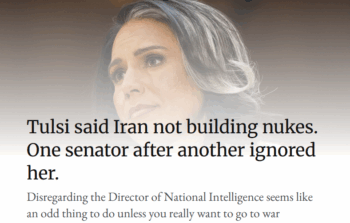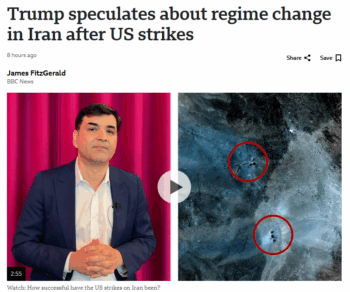
The New York Times (6/18/25) made clear that it wouldn’t mind an unprovoked attack on Iran—so long as it wasn’t done hastily.
In the wake of the US-supported Israeli attack on Iran, and days before the direct US bombing that followed, the New York Times editorial board (6/18/25) argued that “America Must Not Rush Into a War Against Iran.”
This language was as shifty as it was deliberate. Rather than oppose a policy of unprovoked aggression and mass murder, the Times editorialists suggested such a campaign was happening too hastily, and it should be preceded by more debate.
The opinion writers at the most important paper in the world were fully in favor of attacking Iran; they only worried that Trump would go about it the wrong way. In fact, the Times’ justification for war was identical to that of the Trump administration’s explanation after the fact. It laid it out in the first paragraph:
A nuclear-armed Iran would make the world less safe. It would destabilize the already volatile Middle East. It could imperil Israel’s existence. It would encourage other nations to acquire their own nuclear weapons, with far-reaching geopolitical consequences.
The New York Times‘ echo of the standard Israeli and US propaganda line offers an opportunity to critically examine this most recent justification for aggressive war.
‘Iran is not building a nuclear weapon’

The Trump administration’s top intelligence official saying that “Iran is not building a nuclear weapon” (Responsible Statecraft, 6/8/25) did not prevent the New York Times from asserting that Iran “has made substantial progress toward acquiring a nuclear weapon.”
The premise here was that Iran is working to build a nuclear weapon, something that forms the backbone of the Israeli propaganda campaign justifying their actions. The only problem is that there is no evidence whatsoever for this position. Not only is there no evidence that Iran is building a nuclear weapon, there is no reason to think that if they did, they would be anything other than defensive weapons.
Nowhere in the Times analysis was there any reference to the fact that neither US intelligence agencies nor international monitoring organizations have found evidence of any Iranian intention to build a nuclear weapon. As recently as March 25, 2025, Tulsi Gabbard, the Trump administration’s director of national intelligence, told the Senate Select Committee on Intelligence that the US intelligence community “continues to assess that Iran is not building a nuclear weapon and Supreme Leader Khamenei has not authorized the nuclear weapons program that he suspended in 2003.”
While the International Atomic Energy Agency has been critical of steps Iran has taken to make its nuclear power program less transparent in the context of continual threats from Israel and the US to bomb that program, IAEA director Rafael Grossi emphasized in an interview with CNN (6/17/25; cited in Al Jazeera, 6/18/25), after those threats had become reality, “We did not have any proof of a systematic effort to move into a nuclear weapon.”
Unilaterally scrapped

“The Trump administration might well be able to achieve a stricter deal” than the one Obama negotiated in 2015, the Times advised—without mentioning that Trump’s unilateral repudiated the Obama deal (New York Times, 5/8/18).
While the Times editorial did make brief mention of the US’s Obama-era anti-nuclear treaty with Iran, it offered no analysis as to why the Trump administration unilaterally scrapped the deal, despite no violation on Iran’s part. Nor did the paper mention the Biden administration refusal to negotiate a return to the deal. There was no mention of the fact that as Israel launched its first strike against Iran, the Iranians had made it clear that they wished to make a deal with the Trump administration on its nuclear energy program, and were actively negotiating toward that end.
But the fact is that every country in the Middle East, including Iran, has been in favor of a nuclear weapons–free Middle East. Every country, that is, with the exception of Israel, whose illegal, undeclared and often unacknowledged stockpile of nuclear weapons are currently in the hands of a genocidal and messianic regime, hell-bent on attacking its neighbors and thwarting any opportunities for peace.
Despite all of the fearmongering about Iran’s alleged aggressive intent and destabilizing potential, the Times ignored ample analysis and evidence to the contrary. As eminent political scientist John Mearsheimer (PBS, 7/9/12) has argued, a nuclear armed Iran could make the region more stable, because of the deterrent power of nuclear weapons.
A 2009 US military–funded study from the RAND corporation (4/14/09) examined Iranian ”press statements, writings in military journals, and other glimpses into Iranian thinking,” and found that it was extremely unlikely that Iran would use nuclear weapons offensively against Israel. Contrary to the Times’ image of Iran as fanatical theocrats bent on Israel’s destruction at all costs, military planners in Iran are well aware of the danger of being wiped off the map by retaliatory US strikes, and plan accordingly. If the Islamic Republic was to get nuclear weapons, predicts RAND, they would be used to deter exactly the kind of unprovoked attack that the US and Israel have launched over the past several days. They would be defensive, not offensive, weapons.
‘A malevolent force in the world’

The IAEA statement cited by the New York Times was the product of intense lobbying by the US (Common Dreams, 6/23/25).
The editorial board explicitly avoided the question of what Congress should do on the question of war with Iran: “The separate question of whether the United States should join the conflict is not one that we are addressing here.” But they had no problem presenting their pros list:
We know the arguments in favor of doing so—namely, that Iran’s government is a malevolent force in the world, and that it has made substantial progress toward acquiring a nuclear weapon. Last week the International Atomic Energy Agency, which is part of the United Nations, declared that Iran was violating its nonproliferation obligations and apparently hiding evidence of its efforts.
And their cons list:
Given how much weaker Iran is today than it was then, thanks partly to Israel’s humbling of Iranian proxies like Hamas and Hezbollah, the Trump administration might well be able to achieve a stricter [Iran nuclear deal] today.
While the Times correctly pointed out that the IAEA found Iran to be in “noncompliance” with the nonproliferation treaty (NPT), the Times failed to point out that this came after an intense lobbying effort from Western officials just hours before Israeli strikes. They also ignore Iran’s detailed criticism of the IAEA finding, including its allegations that the findings were based in part on forged documents—a credible allegation, given Israel’s history of fabricating and forging evidence to justify aggression. Iran also noted that some of the “nonproliferation obligations” it had allegedly violated were not codified in the NPT, but instead were part of the agreement that the US unilaterally withdrew from. Nor did the Times make reference to the IAEA chief’s explicit insistence that the agency did not have proof Iran was trying to build a nuclear weapon.
‘Let this vital debate begin’

Shortly after Defense Secretary Pete Hegseth said the bombing of Iran “was not and has not been about regime change” (BBC, 6/23/25), Trump posted, “Why wouldn’t there be a regime change???”
Instead of explaining this, the Times went straight to name-calling. One does not have to scrape the annals of the New York Times to predict that the phrase “malevolent force” has never been used to describe any of Washington’s ultra-violent allies, even the ones who have actually built and maintained an illegal stockpile of nuclear weapons. Certainly not Israel, the nation that has put an entire population under military apartheid for decades, and has slaughtered tens of thousands as part of what international rights organizations have labeled a genocide.
The US and Israel have made Iran the target of propaganda campaigns, terrorism, cyber attacks, assassinations, regime change operations and unprovoked attacks on its personnel and home soil. If the Times had included these facts, it would have inhibited the ultimate goal of the editorial: to promote the idea that war with Iran could potentially be desirable—and certainly justifiable. The Times seemed keen to act as a loyal opposition to Trump, while distancing themselves from the manner in which he might enact such a war.
Including the facts of America’s aggressive and provocative behavior against Iran would force them to conclude that the primary force destabilizing the region is not Iran, but the US and Israel. It isn’t Iran whose top papers are weighing the benefits of whether or not to launch a war of aggression against yet another nation. That honor goes to the New York Times, which said of this national discussion of mass murder policy: “Let this vital debate begin.”
After the strikes on Iran, the Trump administration and Israel have not announced full scale regime change war just yet, though there is every indication that such plans are in the works. As with Iraq in 2003, we have seen how easily false claims of weapons of mass destruction, and propaganda about a need to act, can morph into a years-long quagmire of senseless killing in the name of rebuilding a nation according to Washington’s designs. If such a war should be launched against Iran, the Times will have been one of its key supporters.
Research assistance: Emma Llano
ACTION ALERT: You can send a message to the New York Times at letters@nytimes.com or via Bluesky: @NYTimes.com. Please remember that respectful communication is the most effective. Feel free to leave a copy of your message in the comments thread here.
This content originally appeared on FAIR and was authored by Bryce Greene.